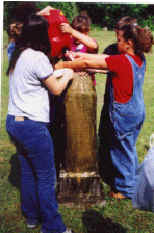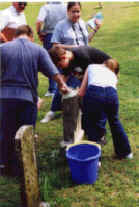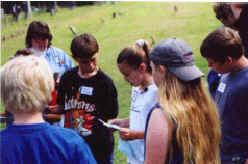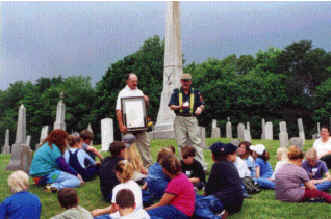The miners of Coal Creek got national exposure by fighting the Tennessee Militia to abolish the convict lease system from 1891 to 1892. After the war, they found a new use for their organizational skills.
An opera house, new roads, new homes, schools, and churches were built. Life was good in Coal Creek for a decade after the Coal Creek War. The new prosperity drew people to Coal Creek looking for good-paying jobs in the coal mines. Briceville-Fraterville-Coal Creek became the most populated part of Anderson County, Tennessee.
Click on image to enlarge
Briceville (Odd Fellow)
Opera House built in 1895,
burned in 1918
Click here to watch
Keith McDaniel's video on
the
Fraterville Mine Disaster
Warning: Get out your tissue and
turn up your speakers

Briceville Community Church built
in
1888 by Welsh immigrant miners
Three mines that never used convicts were Fraterville, Thistle, and Central of the Coal Creek Coal Company. Instead, Major Eldad Cicero (E. C.) Camp, a Civil War Union veteran, U.S. District Attorney, and businessman from Knoxville, organized his company by establishing contracts with experienced miners who were paid based on the tonnage of coal they mined. In the 1890s, the contract miners became members of the United Mine Workers of America. Fraterville, the name of Major Camp's first mine and the surrounding town, means "village of brothers". Fraterville had the reputation of being one of the safest mines in the state and Fraterville miners convinced their relatives to join them in their mining ventures. The miners had the opportunity to own their own land, build their own homes, be paid in cash, and validated the concept of Fraterville as a village of brothers.

Photo of the Fraterville Mine in 1902
Click on image to enlarge
Major Camp's son George learned the mining business working underground with the Fraterville miners. George Camp later became superintendent, supervising the miners who had taught him how to mine coal.
On May 19, 1902, everything changed. The mines grew still when the Fraterville Mine exploded. George Camp had visitors staying in his home and left for work late that morning. On his way to work, a light rain convinced him to return home for a jacket. Otherwise, he would have been underground that morning.
George mounted rescue efforts, but found that all 216 miners had perished. Ten of the miners survived for as long as seven hours before suffocating as documented by poignant farewell messages found on the bodies of Jacob Vowell, Powell Harmon, John Hendren, Harry Beech, Scott Chapman, James Brooks, R.S. Brooks, George Hutson, Frank Sharp, and James Elliott.

Rescue parties went through the
Thistle Mine portal to access the
Fraterville Mine after the
explosion on May 19, 1902

Friends and relatives gathering
outside the adjacent Thistle Mine
awaiting word of the rescue efforts
Caption
from photo published in Knoxville Sentinel -- May 21, 1902
COFFINS CONTAINING DEAD MINERS -- W. R. Queener, a Miner, is shown in
foreground, wearing miner's lamp. He had been at work in mines
thirty-six hours and was only brought out by force, so intense was his
desire to recover the dead
 MINER
POWELL HARMON'S DAUGHTER'S PHOTO: Left to right: Melvin Hurley
Shaver; daughter, Vivian Eileen Shaver; step-son, Donald Edward Allen;
Myrtle Katherine (Harmon) Allen Shaver, daughter of Powell Harmon.
Vivian Shaver was born in July 1923 so this picture appears to have been
taken in late 1923, early 1924 in Columbus, Ohio. Both
of these grandchildren of Powell Harmon went on to earn their college
degrees. Donald Allen earned his Bachelors degree in the ministry and
Vivian Shaver Titus earned a PhD in Education in 1976.
MINER
POWELL HARMON'S DAUGHTER'S PHOTO: Left to right: Melvin Hurley
Shaver; daughter, Vivian Eileen Shaver; step-son, Donald Edward Allen;
Myrtle Katherine (Harmon) Allen Shaver, daughter of Powell Harmon.
Vivian Shaver was born in July 1923 so this picture appears to have been
taken in late 1923, early 1924 in Columbus, Ohio. Both
of these grandchildren of Powell Harmon went on to earn their college
degrees. Donald Allen earned his Bachelors degree in the ministry and
Vivian Shaver Titus earned a PhD in Education in 1976.Click on image to enlarge

Bodies of the 184 known
Fraterville miners were
loaded onto
a train
whereas the bodies of
itinerant miners were
buried
near the mine site
According to a report by the
Tennessee Commissioner of
Labor:
The mine opened in 1870. The furnace was not fired
from Saturday night until Monday morning, and ventilation was stagnated. The
mine was considered to be nongassy although gas was known to be present in
that section of the old and abandoned Knoxville Iron Company mine into which
openings had recently been made. The miners had not been in the mine more
than an hour when at 7:20 am, thick smoke and dust were seen coming from the
ventilating shaft and from the mouth of the mine. Rescuing parties were
organized and penetrated about 200 feet where they came upon the body of a
victim of the afterdamp. They could go no farther and returned to await
dispersal of the deadly gases. At 4:00 pm, a rescue corps again entered.
Brattices had been destroyed, and along the main entry the force of the
explosion was terrific, timbers and cogs placed to hold a squeeze were blown
out, mine cars, wheels, and doors were shattered, and bodies were
dismembered.
In other parts of the mine no heat or violence was shown and suffocation had brought death to those whose bodies were found there. A barricade had been placed across 15 right entry near the heading to protect the miners there from the deadly afterdamp. The 26 men found there must have lived for several hours, as notes were written as late as 2:00 p.m. Gas had accumulated because of inadequate ventilation and was ignited by the open lights. Dust was thick in the mine and was blown up and burned in the explosion.
Click on image to enlarge:
Fraterville widows
and children
Fraterville miner Walter Roberts
and his wife
Mary Melviney Slover Roberts
Shown below are portions of the farewell message written by Jacob Vowell before he suffocated in the Fraterville Mine asking to be buried with his 14-year old son Elbert next to the grave of little Eddie:
Jacob's wife Ellen Webb
Vowell with her children
Lillie & James Vowell and
her father James R. Webb
Click on images to enlarge
 Philip Francis led a rescue party at Fraterville. He
was an experienced Welsh miner, mine owner, and operator from nearby
Jellico, Tennessee. He later wrote in his book "70 Years in the Coal Mines":
Philip Francis led a rescue party at Fraterville. He
was an experienced Welsh miner, mine owner, and operator from nearby
Jellico, Tennessee. He later wrote in his book "70 Years in the Coal Mines":
In the year 1902, when the explosion occurred at Fraterville, they wired for me to come at once and to bring experienced miners with me. This I did. When I arrived at the mine, all was confusion. A few bodies had been brought out. Men, women, and children were crying at the entrance of the mine. It was heart-rending to hear them.
On the inside, you must forget the cries of women and children and also forget many dangers that surround you in the mine. You have a duty to perform to a fellow miner and to remove dead bodies to their relatives on the outside. The first bodies we came to were on their knees in a praying position.
The last evening, when I reached the outside of the mine, an old white-haired man came running to me and asked me if we had found his grandson. He said he had a wide leather belt around his waist. The old man was heart-broken. It took force to keep him from going into the mine. Finally, part of a boy’s body was brought out. It was his grandson. When clearing up the mine we found a boy’s torso with the belt still around his body.
To read the autobiography of rescuer Philip Francis, visit his great grandson’s web page at www.geocities.com/seventyyearsinthecoalmines/

Common headstone of Jacob and
Elbert
Vowell, located adjacent to the headstone
of little Eddie Vowell, being cleaned
by Briceville School students
 At an inquest, George Camp was
initially accused of negligence, but was later acquitted. In his defense,
he cited the exemplary 30-year safety record of the mine. He furnished
letters from state inspectors verifying that modifications required by them
had been made. According to the May 23, 1902, Knoxville Sentinel news
account of the inquest, "George Camp, the young man who has grown up as a
comrade to the dead men and who became skilled in the mining business under
the tutelage of the men now dead, wept bitterly on the stand".
At an inquest, George Camp was
initially accused of negligence, but was later acquitted. In his defense,
he cited the exemplary 30-year safety record of the mine. He furnished
letters from state inspectors verifying that modifications required by them
had been made. According to the May 23, 1902, Knoxville Sentinel news
account of the inquest, "George Camp, the young man who has grown up as a
comrade to the dead men and who became skilled in the mining business under
the tutelage of the men now dead, wept bitterly on the stand".PHOTO OF GEORGE CAMP
The ventilation furnace operator, Tip Hightower, was also accused of negligence. George Camp could have diverted blame from himself by allowing blame to be placed on the furnace operator. Instead, he testified at the inquest, "Tip Hightower never let his fire die down. I always found his fire all right. He was trustworthy". Tip Hightower had two sons who died in the Fraterville explosion. He was acquitted at the inquest based on the testimony of George Camp.

Headstones of Condy Harmon and
Powell Harmon
being cleaned (despite
his father's warning,
Condy was
killed in the
Cross Mountain
mine disaster of 1911)
Ironically, the explosion likely occurred because the Fraterville Mine had intercepted unventilated workings of the adjacent Knoxville Iron and Coal Company Mine No. 1 that had been previously mined by convict laborers and abandoned. When the Fraterville miners with their open oil lamps reached the area near the abandoned mine workings, methane gas ignited and set off an explosion of airborne coal dust. The Fraterville tragedy was exacerbated by the fact that male members of entire families perished including five Dezern brothers, Peter Childress and his three sons, John McKamey and his three sons, seven Webb’s, and eight Wallace’s. The explosion left only three adult males alive in the town of Fraterville. Hundreds of women were widowed and about 1000 children were left without a father. One mother lost five of her sons and two of her daughters lost their husbands. One young girl lost eight uncles in the disaster. The youngest miner killed at Fraterville was 12 years old.
Tony Thomas singing, "When the mines grew still in Fraterville" at the Fraterville Itinerant Cemetery
 Farewell message of Powell Harmon,
Farewell message of Powell Harmon,
who
said "My boys, Henry and Condy,
never work in the coal mines",
being read at
his headstone
in Longfield Cemetery

Briceville School students being
presented with
a Resolution from the
Tennessee General
Assembly
recognizing their study of
Coal Creek history at the
Miners' Circle
in Leach Cemetery
Many of the headstones of the Fraterville miners
contain the inscription "Gone but not forgotten". Today, Memorial Day is
celebrated on May 19 in Coal Creek in honor of the miners who died at
Fraterville. Fraterville Miners’ Circle in Leach Cemetery was placed on the
National Register of Historic Places in 2005.



